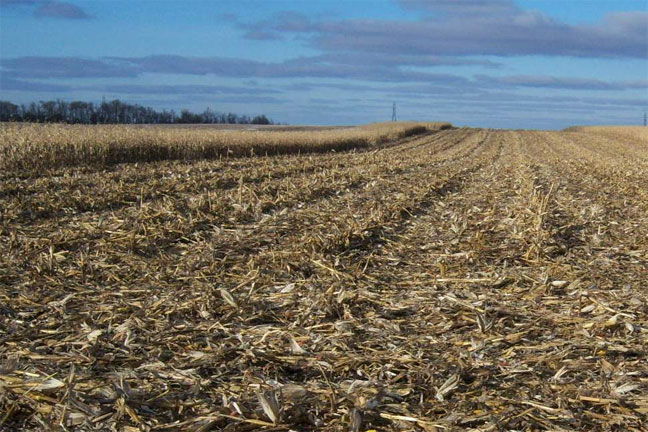
Agricultural News
Partial Corn Stover Removal Reduces Management Challenges
Tue, 27 Nov 2012 10:01:50 CST

Corn residue increases proportionally with corn yields, creating management challenges for growers. To help address those, agronomists and scientists from DuPont Pioneer and DuPont Industrial Biosciences teamed up to conduct research on the impact of residue removal on the long-term agronomic and environmental integrity of fields. Stover is also evaluated for cellulosic ethanol production, which has benefits for both farmers and biofuel producers.
"In fields where partial stover removal is an option, a sustainable stover harvest program provides value to the grower without negatively impacting the health and productivity of the soil," says Andy Heggenstaller, DuPont Pioneer agronomy research manager for cellulosic ethanol. "There are three primary factors we examine with growers considering stover harvest, including field productivity level, crop management practices and erosion potential."
Individual field evaluation is necessary as stover removal is not an option for every field. In some highly productive systems, residue may even be excessive as a result of increased yields, improved stalk quality and reduced tillage practices. Highly productive, relatively flat, continuous corn fields are best suited for stover removal and tend to see the greatest agronomic benefits. In these fields, corn stover production generally exceeds the minimum amount needed to maintain soil health and productivity, making sustainable stover harvest a viable option.
In high yielding areas of the Corn Belt, many growers are chopping stalks, increasing tillage or using a combination of these two methods to further stalk decomposition. In areas where residue management is a critical factor in production decisions, partial stover harvest could expand rotation and farming options. For example, reducing excess residue could allow increased flexibility in managing corn following corn, particularly in the northern Corn Belt where residue decomposition tends to be slower. Stover removal also may eliminate tillage operations and other practices used primarily for residue management, resulting in substantial production cost savings.
Agronomic advantages of partial stover removal include accelerated spring soil warming and drying, improved stand establishment, reduced nitrogen immobilization, reduced disease pressure, expanded rotation options and reduced tillage. Studies also have shown yield advantages for corn when excess stover is removed. The remaining residue in a sustainable stover harvest program ensures soil erosion prevention, soil organic carbon maintenance and soil fertility management.
"Concern with removal of organic matter and nutrients with the stover harvest tends to be the primary limiting factor on the minds of growers," reports Heggenstaller.
As fields are evaluated for stover harvest, the estimated productivity level guides the amount of residue left on the field. Typically, corn grain and stover are produced in a roughly one-to-one ratio. If a field yields 150 bushels per acre, which equals 3.6 tons of grain at 0 percent moisture, it should produce approximately 3.6 tons of stover. In general, every field under continuous corn with no-till or conservation tillage needs about 2.3 tons of residue per acre to keep organic matter constant. As corn yields grow, stover increases, resulting in greater potential for stover removal in highly productive fields.
Soil erosion is another major consideration. A sustainable stover harvest program must leave enough residue on the soil to mitigate water and wind erosion. The amount of residue needed to manage erosion varies greatly depending on field characteristics and management practices, but it is often significantly less than the total produced. Tools such as RUSLE2 (Revised Universal Soil Loss Equation, version 2) and WEPS (Wind Erosion Prediction System) are available to develop a soil conservation plan.
From a soil fertility standpoint, the impact of a stover harvest is complex. A partial stover harvest will increase the removal of plant nutrients; however, short- and long-term effects will vary for different nutrients. Nutrient removal tables provide estimates of pounds of nutrients per ton of dry stover. The tables are useful as a general guide, but they tend to overestimate the amount of nutrients actually removed by a stover harvest. In general, growers should monitor fertility and account for nutrient removal in fertility programs, particularly with phosphorus and potassium.
"When considering stover harvest, growers should be thinking where they want to go with crop production, not where they are today," says Heggenstaller. "As grain yields and residue levels increase, it becomes more sustainable and economical to harvest a portion of stover and use it to produce other products than to till it into the soil."
WebReadyTM Powered by WireReady® NSI
Top Agricultural News
More Headlines...



















